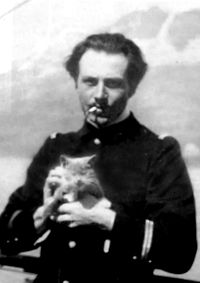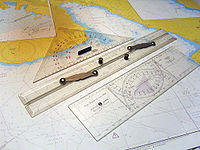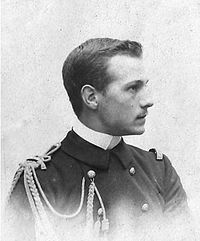
Jean Cras
Encyclopedia

Brittany
Brittany is a cultural and administrative region in the north-west of France. Previously a kingdom and then a duchy, Brittany was united to the Kingdom of France in 1532 as a province. Brittany has also been referred to as Less, Lesser or Little Britain...
, his travels to Africa, and most of all, by his sea voyages. As a naval commander he served with distinction in the Adriatic Campaign
Adriatic Campaign of World War I
The Adriatic Campaign of World War I was a naval campaign fought during World War I between the Central Powers, and the Mediterranean squadrons of Great Britain, France, the Kingdom of Italy, Australia and the United States.-Characteristics:...
during World War I.
Naval career

Brest, France
Brest is a city in the Finistère department in Brittany in northwestern France. Located in a sheltered position not far from the western tip of the Breton peninsula, and the western extremity of metropolitan France, Brest is an important harbour and the second French military port after Toulon...
. His father was naval medical officer. He was accepted into the navy at the age of seventeen. As a midshipman cadet on the Iphigenie, he fought in the Americas, the West Indies and Senegal. He was promoted to Lieutenant in 1908. His mathematical skills led to his proposing a number of innovations in technical practices which were adopted by the navy, including his invention of an electrical selector and a navigational plotter protractor (which was named after him).
With the outbreak of war in 1914 Cras was appointed as adjutant to Admiral Augustin Boué de Lapeyrère
Augustin Boué de Lapeyrère
Augustin Manuel Hubert Gaston Boué de Lapeyrère was a French admiral during World War I. He was a strong proponent of naval reform, and is comparable to Admiral Jackie Fisher of the British Royal Navy.-Biography:...
. He later worked in the Submarine Defense Service. In 1916 he was appointed commander of the torpedo boat
Torpedo boat
A torpedo boat is a relatively small and fast naval vessel designed to carry torpedoes into battle. The first designs rammed enemy ships with explosive spar torpedoes, and later designs launched self-propelled Whitehead torpedoes. They were created to counter battleships and other large, slow and...
Commandant Bory. During the Adriatic campaign he sank a submarine and was commended for his bravery in rescuing a sailor who had fallen overboard.
After the war Cras became Chief Secretary to the Chief of General Staff, and was promoted to Commander. He served on several other vessels before being appointed Service Chief on the General Staff for Scientific Research. In 1931 he was appointed Major General of the Port of Brest and promoted to rear admiral
Rear Admiral
Rear admiral is a naval commissioned officer rank above that of a commodore and captain, and below that of a vice admiral. It is generally regarded as the lowest of the "admiral" ranks, which are also sometimes referred to as "flag officers" or "flag ranks"...
. He occupied this position when he died after a short illness.
Musical career

Polyphème
Polyphème is an opera composed by Jean Cras with a libretto by Albert Samain. It was written by Cras during World War I and was premiered in Paris in 1922, giving Cras a burst of notoriety in the French press.-Text:...
, was written and orchestrated during the war, however the majority of his musical output dates from after the war. Today, his string trio and string quartet are his best known works.
His lyric tragedy, Polyphème is considered his masterpiece. The opera was acclaimed at its premiere in 1922, giving Cras a burst of notoriety in the French press. The title character is Polyphemus
Polyphemus
Polyphemus is the gigantic one-eyed son of Poseidon and Thoosa in Greek mythology, one of the Cyclopes. His name means "much spoken of" or "famous". Polyphemus plays a pivotal role in Homer's Odyssey.-In Homer's Odyssey:...
, who, according to Greek mythology
Greek mythology
Greek mythology is the body of myths and legends belonging to the ancient Greeks, concerning their gods and heroes, the nature of the world, and the origins and significance of their own cult and ritual practices. They were a part of religion in ancient Greece...
, is the eldest Cyclops
Cyclops
A cyclops , in Greek mythology and later Roman mythology, was a member of a primordial race of giants, each with a single eye in the middle of his forehead...
and son of Poseidon
Poseidon
Poseidon was the god of the sea, and, as "Earth-Shaker," of the earthquakes in Greek mythology. The name of the sea-god Nethuns in Etruscan was adopted in Latin for Neptune in Roman mythology: both were sea gods analogous to Poseidon...
. It tells the well-known story of the attempt by Polyphemus (baritone) to steal Galatea
Galatea (mythology)
-Name "Galatea":Though the name "Galatea" has become so firmly associated with Pygmalion's statue as to seem antique, its use in connection with Pygmalion originated with a post-classical writer. No extant ancient text mentions the statue's name...
(soprano) from Acis
ACIS
The 3D ACIS Modeler is a 3D modelling kernel owned by Spatial Corporation . ACIS is used by many software developers in industries such as computer-aided design , Computer-aided manufacturing , Computer-aided engineering , Architecture, engineering and construction , Coordinate-measuring machine...
(tenor). In the original myth Polyphemus eventually kills Acis by rolling a rock onto him. Albert Samain
Albert Samain
Albert Victor Samain was a French poet and writer of the Symbolist school.Born in Lille, his family were Flemish and had long lived in the town or its suburbs. At the time of the poet's birth, his father, Jean-Baptiste Samain, and his mother, Elisa-Henriette Mouquet, conducted a business in "wines...
, the librettist, humanized Polyphemus by having him become aware of the feelings shared by two lovers and thus, decide not to crush them. Ultimately, the cyclops wanders into the sea to find death because the couple's happiness horrifies him. The music is impressionistic, restless, and highly chromatic, in the spirit of Chausson
Ernest Chausson
Amédée-Ernest Chausson was a French romantic composer who died just as his career was beginning to flourish.-Life:Ernest Chausson was born in Paris into a prosperous bourgeois family...
and Duparc. The influence of Debussy's opera Pelléas et Mélisande
Pelléas et Mélisande (opera)
Pelléas et Mélisande is an opera in five acts with music by Claude Debussy. The French libretto was adapted from Maurice Maeterlinck's Symbolist play Pelléas et Mélisande...
is also noticeable. (A fine recording of this opera was released in 2003, with Bramwell Tovey conducting the Luxembourg Philharmonic Orchestra and Armand Arapian in the title role.)
Cras's later work developed a more acerbic style comparable to that of Bartók, though formally close to César Franck
César Franck
César-Auguste-Jean-Guillaume-Hubert Franck was a composer, pianist, organist, and music teacher who worked in Paris during his adult life....
. He considered chamber music to be his forte, writing that "this refined musical form has become for me the most essential". The String Trio in particular integrates a wide range of styles, including North African influences. It was a described as a 'miraculous' work by André Himonet in 1932, achieving "perfectly balanced sonority and a plenitude of expression between which one dare not choose." The Trio for Strings and Piano also blends African and Eastern melodic patterns with Breton musical traditions into a coherent whole. The critic Michel Fleury compares his work to the Japonist
Japonism
Japonism, or Japonisme, the original French term, was first used in 1872 by Jules Claretie in his book L'Art Francais en 1872 and by Philippe Burty in Japanisme III. La Renaissance Literaire et Artistique in the same year...
style of the artist Henri Rivière
Henri Rivière (painter)
Henri Rivière was a French artist and designer best known for his creation of a form of shadow play at the Chat Noir cabaret, and for his post-Impressionist illustrations of Breton landscapes and the Eiffel Tower....
revealing "a stylised Breton land, as though it had been passed through the sieve of his varied experiences gained in the four quarters of the globe."
Opera
- PolyphèmePolyphèmePolyphème is an opera composed by Jean Cras with a libretto by Albert Samain. It was written by Cras during World War I and was premiered in Paris in 1922, giving Cras a burst of notoriety in the French press.-Text:...
, opera in five acts on a lyric drama by Albert SamainAlbert SamainAlbert Victor Samain was a French poet and writer of the Symbolist school.Born in Lille, his family were Flemish and had long lived in the town or its suburbs. At the time of the poet's birth, his father, Jean-Baptiste Samain, and his mother, Elisa-Henriette Mouquet, conducted a business in "wines...
(1910–1918, Ed. Salabert) (f.p. Opéra-Comique, Paris, 29 December 1922.)
Published excerpts:
- N° 1: « Oh ! qui m’enlèvera… », Polyphème: Act III, scene 1, (1921, SenartMaurice SenartÉditions Maurice Senart was an important French music publisher founded by Maurice Senart operating in Paris from 1908 to 1941....
) - N° 2: « Il est parti… Pourquoi faut-il que l'heure arrive », Galatée: Act IV, scene 5, (1921, Senart)
- Le Sommeil de Galatée, musical interlude from Act I, (1922, Senart)
Vocal Compositions
- (1892–1896, numerous songs in manuscript, "Album de jeunesse")
- Panis angelicus (August 1899, ms.)
- Sept mélodies, (poems by Rodenbach, Droin, Verlaine, Baudelaire) for voice and piano (1899–1905, Ed. Salabert)
-
- 1. Douceur du soir, poem by Georges RodenbachGeorges RodenbachGeorges Raymond Constantin Rodenbach was a Belgian Symbolist poet and novelist.- Biography :Georges Rodenbach was born in Tournai to a French mother and a German father from the Rhineland . He went to school in Ghent at the prestigious Sint-Barbaracollege, where he became friends with the poet...
(1901) - 2. Mains lasses, poem by Georges Rodenbach (1905)
- 3. L’espoir luit, poem by Paul VerlainePaul VerlainePaul-Marie Verlaine was a French poet associated with the Symbolist movement. He is considered one of the greatest representatives of the fin de siècle in international and French poetry.-Early life:...
(Sagesse III), (1900, 1st ed.; 1909, éd. mutuelle de la Schola Cantorum) - 4. Le Son du cor, poem by Paul Verlaine (Sagesse X), (1900)
- 5. Rêverie, poem by Alfred Droin, (1903, 1st ed.; 1909, éd. mutuelle de la Schola Cantorum)
- 6. Nocturne, poem by Alfred Droin, (1903, 1st ed.; 1909, éd. mutuelle de la Schola Cantorum)
- 7. Correspondances, poem by Charles BaudelaireCharles BaudelaireCharles Baudelaire was a French poet who produced notable work as an essayist, art critic, and pioneering translator of Edgar Allan Poe. His most famous work, Les Fleurs du mal expresses the changing nature of beauty in modern, industrializing Paris during the nineteenth century...
(1901)- Ave verum, for voice, violin, organ (or harmonium) (1905, ms.)
- Deuxième messe à 4 voix a capella (1907–08, ms.)
- 1. Kyrie (1907)
- 2. Gloria (1907)
- 3. Sanctus (1908)
- 4. Benedictus (1908)
- Regina coeli, voices with organ (1909, pub. 1914, Ed. Schola Cantorum)
- Ave Maria, for voice with organ (August 1910, ms.)
- Elégies (four poems by Albert Samain), for voice with orchestra (1910, Ed. Durand)
- L’Offrande lyrique (seven poems by Rabindranath TagoreRabindranath TagoreRabindranath Tagore , sobriquet Gurudev, was a Bengali polymath who reshaped his region's literature and music. Author of Gitanjali and its "profoundly sensitive, fresh and beautiful verse", he became the first non-European Nobel laureate by earning the 1913 Prize in Literature...
, transl. André GideAndré GideAndré Paul Guillaume Gide was a French author and winner of the Nobel Prize in literature in 1947. Gide's career ranged from its beginnings in the symbolist movement, to the advent of anticolonialism between the two World Wars.Known for his fiction as well as his autobiographical works, Gide...
), for voice with piano (1920/1, Ed. Salabert) - Image (poem by E. Schneider), for voice with piano (1921, Ed. Salabert)
- Fontaines (five poems by Lucien Jacques), for voice & orchestra, or for voice & piano (1923, Ed. Salabert)
- Cinq Robaïyats (five Persian quatrains by Omar KhayyamOmar KhayyámOmar Khayyám was aPersian polymath: philosopher, mathematician, astronomer and poet. He also wrote treatises on mechanics, geography, mineralogy, music, climatology and theology....
, transl. Franz Toussaint), for voice with piano (1924, Ed. Salabert) - Dans la montagne (poems by Maurice Boucher), five chorales for male quartet (1925, Ed. Salabert)
- Hymne en l'honneur d'une Sainte (text by Jean Cras) for female voices with organ (1925, Ed. Salabert)
- Vocalise-Etude, for voice and piano (1928, Ed. Leduc)
- La Flûte de Pan for voice, Pan-pipes, violin, viola and cello (four poems by Lucien Jacques), (1928, Ed. Salabert)
- Soir sur la mer (poem by Virginie HériotVirginie HériotVirginie Claire Désirée Marie Hériot was a French yachtswoman who won in the 1928 Summer Olympics in the 8 Metre Aile VI...
), for voice and piano (1929, Ed. Salabert) - Trois Noëls (poems by Léon Chancerel), for voices and chorus with piano (1929, Ed. Salabert)
- Trois chansons bretonnes (poems by Jean Cras), for voice and piano (1932, Ed. Salabert)
- Deux chansons: le roi Loudivic, Chanson du barde, extracts from Chevalier étranger by Tanguy Malmanche, for voice and piano (1932, Ed.Salabert)
- 1. Douceur du soir, poem by Georges Rodenbach
Chamber music
- Voyage symbolique (premier trio), for piano, violin & cello (1899, ms.)
- L'Esprit (première sonate), for violin & piano (1900, ms.)
- L'Âme (deuxième sonate), for viola & piano (1900, ms.)
- La Chair (troisième sonate), for cello & piano (1900, Ed. Durand)
- Trio en ut pour piano, violon et violoncelle (1907, Ed. Durand)
- À ma Bretagne, string quartet (1909, Ed. Salabert)
- Quintette, for flute, harp, violin, viola, cello & piano, or for piano and string quartet (1922, Ed. Salabert)
- Prélude et danse: Demain, saxophone quartet (1924–1926, ms.)
- Deux Impromptus pour harpe (1925, Ed. Salabert)
- Trio pour violon, alto et violoncelle (1925, Ed. Salabert; 1927, Senart) Senart Edition, miniature score (publ. 1927) From Sibley Music Library Digital Scores Collection
- Quatre petites pièces pour violon et piano:
-
- 1. Air varé (1926, Ed. Salabert)
- 2. Habañera (1927, Ed. Salabert)
- 3. Evocation (1928, Ed.Salabert)
- 4. Epologue (1929, Ed. Salabert)
- Suite en duo, for flute & harp, or for violin & piano (1927, Ed. Salabert)
- Quintette pour harpe, flûte, violon, alto et violoncelle (1928, Ed. Salabert)
- Légende, for cello & piano (reduction of work for cello & orchestra) (1930, Senart)
Piano works
- Impromptu pastoral (1900, ms.)
- Petite pièce en fa mineur (1901, ms.)
- Valse en mi majeur (1904, ms.)
- Cinq poèmes intimes pour piano: (1912, E. Demets)
-
- 1. En Islande (1902, Ed. Eschig)
- 2. Preludio con fughetta (1902, Ed. Eschig)
- 3. Au fil de l'eau (1911, Ed. Eschig)
- 4. Recueillement (1904, Ed. Eschig)
- 5. La maison du matin (1911, Ed. Eschig)
- Deux Paysages: Paysage maritime, Paysage champêtre, piano solo (1917, Ed. Durand)
- Danze (1917, Rouart, Lerolle et cie.)
- Quatre Danze: Danza morbida, Danza scherzosa, Danza tenera, Danza animata, piano solo (1917, Ed. Salabert)
- Âmes d'enfants, pour 6 petites mains, piano six handsPiano six handsMusic described as piano six hands is for three pianists at one piano, as distinct from piano duet which is music for two pianists at one piano, and from piano trio which is music for piano, violin and cello...
(1917, ms.), piano four hands (1922, Senart), also orchestrated (1918, Ed. Salabert) - Premier anniversaire, « A mon petit Jean-Pierre » (1 May 1919, ms.)
- First string quartet, version for piano, 4 mains, (1921, Rouart, Lerolle et cie.)
- Deux impromptus, for piano or harp, (1926, Senart)
Organ
- Chorale (1904, ms.)
- Grande marche nuptiale pour orgue (1904, Ed. Schola Cantorum)
Orchestral works
- Andante religieux (1901, ms.)
- Âmes d'enfants, orchestration of work for « piano et 6 petites mains » (1921, Senart)
- Journal de bord, Suite symphonique (1927, Ed. Salabert)
- Légende pour violoncelle et orchestre (1929, Ed. Salabert)
- Concerto pour piano et orchestre (1931, Ed. Salabert), (reduction for 2 pianos, 1932, Senart)
External links
- Recent Repertoire Discoveries from France, article by Paul-André Bempéchat with a summary of Cras' career, from Cello.org.
- Death of Monique Cras, daughter of Jean Cras, article by Paul-André Bempéchat, (in English) from Agence Bretagne Presse.
- Jean Cras, article & catalogue d'oeuvres by Marie-Claire Mussat (in French), from Musiques et danses de Bretagne.
- Jean Cras : un destin hors norme, article (in French) from AbeilleInfo.com.
- String Trio Score from Sibley Music Library Digital Scores Collection.
- Jean Cras at Compositeurs Bretons
- Jean Cras String Trio & Piano Trio soundbites and discussion of works

